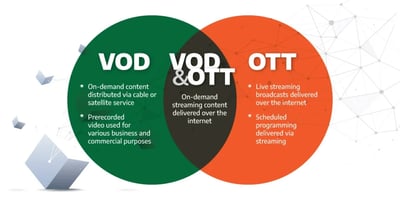1. A Data Tsunami No One Saw Coming 2. The Foundations: How a Video CDN Really Works 3. Why Latency...
Adaptive Streaming Over CDN: Key Insights and Benefits
In the rapidly evolving world of digital content delivery, adaptive streaming over CDN (Content Delivery Network) has emerged as a game-changer. This innovative approach optimizes the streaming experience across various network conditions and devices, ensuring that end-users receive the best possible quality without interruptions. As more businesses and media companies seek to enhance their digital offerings, understanding the nuances and advantages of adaptive streaming over CDN becomes imperative.
Introduction to Adaptive Streaming
Adaptive streaming is a technology that dynamically adjusts video quality based on the user's network conditions. Unlike traditional streaming, which sends a single video file, adaptive streaming breaks the video into smaller chunks and delivers them according to the current bandwidth. This ensures seamless playback and reduces buffering, providing an enhanced viewing experience.
How Adaptive Streaming Works
The process begins with encoding the video at multiple bitrates. These different versions are then stored on a CDN. When a user requests the video, the system detects their network speed and selects the appropriate bitrate to deliver smooth playback. If the network conditions change, the stream automatically adjusts to a higher or lower bitrate, ensuring continuous video delivery.

Benefits of Adaptive Streaming Over CDN
The combination of adaptive streaming and CDN technology offers numerous benefits to both content providers and end-users:
1. Improved User Experience
Adaptive streaming ensures that viewers receive the highest quality video their network can support without interruptions. This results in a better user experience, leading to longer viewing times and higher user satisfaction.
2. Bandwidth Optimization
By dynamically adjusting the video quality based on real-time network conditions, adaptive streaming helps optimize bandwidth usage. This is particularly beneficial for ISPs and network providers, as it reduces the load on their networks during peak times.
3. Scalability
Adaptive streaming over CDN allows for efficient scaling of video delivery to large audiences. CDNs cache content closer to end-users, reducing latency and ensuring that large-scale live events or viral videos can be delivered smoothly to millions of viewers simultaneously.
4. Cost Efficiency
From a content provider's perspective, adaptive streaming reduces the need for provisioning excessive bandwidth, leading to cost savings. Additionally, using a CDN for content delivery further reduces costs by minimizing the load on the origin server.
Technical Insights into Adaptive Streaming
Encoding and Transcoding
To implement adaptive streaming, videos must be encoded at multiple bitrates. This process, known as transcoding, generates various quality versions of the same video. Advanced encoders such as H.264, H.265, and VP9 are commonly used for this purpose, balancing quality and compression efficiency.
Segmenting and Manifest Files
Once encoded, the video is divided into small chunks, typically 2-10 seconds each. These segments are indexed in manifest files (e.g., M3U8 for HLS, MPD for DASH), which guide the player's decision on which segment to download next based on the current network conditions.
CDN Integration
CDNs play a crucial role in adaptive streaming by caching video segments closer to end-users. This reduces latency and ensures fast, reliable delivery, even under fluctuating network conditions. Services like BlazingCDN offer specialized solutions that further enhance the performance and scalability of adaptive streaming.
Popular Use Cases
Adaptive streaming over CDN is widely used across various industries, including:
1. Media and Entertainment
From OTT platforms to live sports and events, adaptive streaming ensures that viewers get uninterrupted access to high-quality content, regardless of their device or network speed.
2. E-Learning
Educational institutions and e-learning platforms use adaptive streaming to deliver video lectures and course materials. This ensures that students can access content seamlessly, even on slower connections.
3. Corporate Communications
Businesses leverage adaptive streaming for internal communications, training, and webinars, ensuring that employees across different locations receive clear and uninterrupted video content.
Challenges and Best Practices
While adaptive streaming offers significant advantages, it also presents certain challenges:
1. Encoding Complexity
Encoding videos at multiple bitrates can be resource-intensive. Using cloud-based encoding services or hardware accelerators can help manage this complexity.
2. Latency Management
Ensuring low latency is critical for live streaming. Techniques like chunked transfer encoding and low-latency protocols (e.g., Low-Latency HLS) can help minimize delays.
3. DRM and Security
Adaptive streaming must be coupled with robust DRM solutions to protect content from unauthorized access and piracy. Implementing secure token-based authentication and encryption can safeguard the stream.
Future Trends
As technology evolves, adaptive streaming continues to advance. Some of the notable trends include:
1. AI and Machine Learning
AI-driven analytics can optimize adaptive streaming by predicting network conditions and pre-adjusting the bitrate. Machine learning algorithms can enhance encoding efficiency and quality.
2. 5G Integration
The rollout of 5G networks promises to revolutionize adaptive streaming by providing ultra-low latency and high bandwidth. This will enable seamless delivery of 4K and even 8K content.
3. Enhanced Player Technologies
Modern video players are incorporating advanced features like buffer management, error correction, and adaptive bitrate algorithms, further improving the streaming experience.
For companies looking to leverage the full potential of adaptive streaming over CDN, exploring tailored solutions like those offered by BlazingCDN can provide a significant competitive edge.
Engage with us further by exploring more about our innovative solutions on BlazingCDN Blog.


